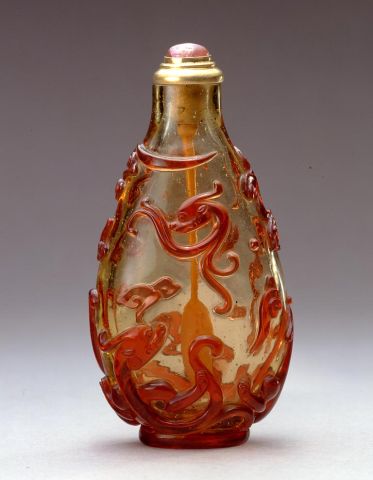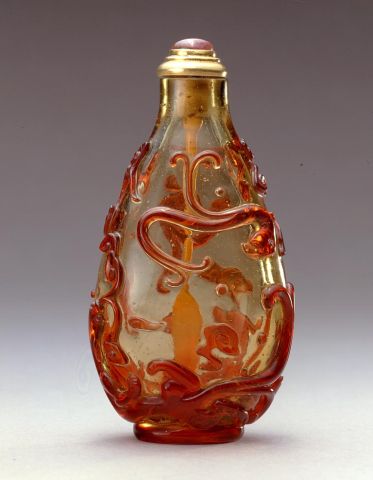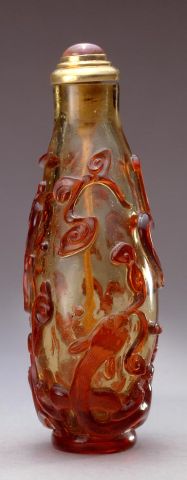


Bottle ID: 00403
YELLOW W/RED OVERLAY, DRAGONS
Date: 1740-1820
Height: 71 mm
Glass, of flattened elongated pear shape, overlaid with red on an amber-yellow ground with four coiling chi dragons, two young ones without their hind legs, floating amidst formalized clouds, the footrim in the red overlay color.
Probably Imperial, attributed to the Palace Workshops, Beijing.
Similar Examples:
Soler, Silvia, Tabaqueras Chinas, Madrid, 1990, no. 45.
Sotheby's, New York, April 1, 2005, Collection of Avrina Pugh, lot 372.
Moss, Hugh, Victor Graham and Ka Bo Tsang. A Treasury of Chinese Snuff Bottles - The Mary and George Bloch Collection, 2002, Vol. 2, Part 5, p. 450, no. 882.
Chinese Snuff Bottles. Hugh M. Moss Ltd. Catalogue, London, 1976, pp.16-17,
no. 43.
Provenance:
Hugh Moss [HK] Ltd.
Clatworthy Collection
Madalena Collection, Switzerland
Exhibited:
Annual Convention ICSBS Toronto, October 2007
Although stylistically unusual for an imperial attribution, the subject matter of chi dragons, together with the color combination of red over amber-yellow, would suggest the Palace Workshops as a likely place of production. The background color of amber-yellow is more often seen in examples with an opaque yellow overlay such as The Crane Collection No. 167, or in equally rare cases, with a green overlay. A second example of a red on amber-yellow glass is No. 292 in The Crane Collection where the subject matter is also dragons but executed in the more traditional style. Zhang Rong, from the Palace Museum Beijing, notes that the Palace Archives records show that the glass-house produced 57 glass cups in white, blue and golden amber during the 5th-6th years of the Yongzheng period (1727-1728), indicating that by this time the glass workers in the Palace were already capable of producing pieces in this color. The fluid style of carving of the above example is seldom seen, giving the bottle an elegant and ethereal appearance, but prohibiting it from being attributed easily to any particular group. It is as though the carver has a brush in his hands, rather than a standard lapidary tool, producing a unique and enduring work of art.
< Back to full list
 English
English 中文
中文